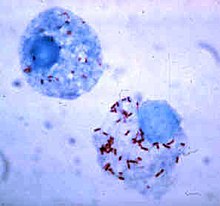
Lead
Intracellular bacteria are bacteria that have the capability to enter and survive within the cells of the host organism. These bacteria include many different pathogens that live in the cytoplasm and nuclei of the host cell's they inhabit. Two examples of intracellular pathogenic bacteria are Mycobacterium tuberculosis and also Toxoplasma gondii. There are two types of intracellular bacteria: facultative intracellular bacteria, which can grow extracellularly or intracellularly, and obligate intracellular bacteria, which can grow only intracellularly.
Body
Facultative Intracellular Bacteria
Examples of facultative intracellular bacteria include members of the genera Brucella, Legionella, Listeria, and Mycobacterium. These bacteria invade the human body and replicate inside the cells, evading the immune system and causing disease by disrupting the human's cells normal function. Diseases caused by facultative intracellular bacteria include Listeriosis (Listeria monocytogenes), Typhoid Fever (Salmonella typhi), Legionnaires' disease (Legionella pneumophila), and Salmonellosis (Salmonella enterica) to name a few. While they can invade the human body, they are also capable of living extracellularly. These bacteria can replicate within the environment, sustain their metabolic state, and survive harsh conditions by using mechanisms such as a bacterium-containing vacuole, lysosome resistance, and entering a survival state called persistence.
Obligate Intracellular Bacteria
Examples of obligate intracellular bacteria include members of the order Rickettsiales and members of the genus Mycoplasma. These bacteria need the human host to be able to reproduce and when they have invaded the body, they cause disease. Unlike facultative intracellular bacteria that can grow within or outside of a host's body, obligate bacteria cannot survive without host cells. These bacteria cannot reproduce outside of the host cell because they lack the metabolic processes and enzymes needed to reproduce, which the host cell gives them. Diseases caused by obligate intracellular bacteria include Chlamydia (Chlamydia trachomatis), Rocky Mountain Spotted Fever (Rickettsia rickettsii), and Tuberculosis (Mycobacterium tuberculosis) to name a few.
Infectious Pathways
Hosts usually come into contact with the bacteria through the skin, but there are chances of contracting the bacteria from a bite, such as that of ticks, mites, and/or mosquitoes (Rickettsia rickettsii). Listeria monocytogenes is found in soil, water, and also decaying animals and plants. It is generally transmitted through food being processed or handled in areas contaminated with L. monocygotenes. Legionella pneumoniae are found in aquatic conditions, such as artificial water systems, like that of hot tubs and showers. Salmonella typhi and Salmonella enterica are both transmitted orally through feces or through food and/or water that has the bacteria. Chlamydia trachomatis is spread by having unprotected sex. Mycobacterium tuberculosis is spread through the air when being near anyone with tuberculosis.
See also
References
- ^ Levinson, Warren (2018). Review of medical microbiology and immunology (15th ed.). New York. ISBN 978-1-259-64450-4. OCLC 1225889723.
{{cite book}}: CS1 maint: location missing publisher (link) - Haridas, Viraga; Ranjbar, Shahin; Vorobjev, Ivan A.; Goldfeld, Anne E.; Barteneva, Natasha S. (2017-01-01). "Imaging flow cytometry analysis of intracellular pathogens". Methods. Flow Cytometry. 112: 91–104. doi:10.1016/j.ymeth.2016.09.007. ISSN 1046-2023. PMC 5857943.
- ^ Leon-Sicairos, Nidia; Reyes-Cortes, Ruth; Guadrón-Llanos, Alma M.; Madueña-Molina, Jesús; Leon-Sicairos, Claudia; Canizalez-Román, Adrian (2015). "Strategies of Intracellular Pathogens for Obtaining Iron from the Environment". BioMed Research International.
- Jiao, Hanwei; Zhou, Zhixiong; Li, Bowen; Xiao, Yu; Li, Mengjuan; Zeng, Hui; Guo, Xiaoyi; Gu, Guojing (2021). "The Mechanism of Facultative Intracellular Parasitism of Brucella". International Journal of Molecular Sciences. 22 (7).
- Mak, Tak W.; Saunders, Mary E.; Jett, Bradley D., eds. (2014-01-01), "Chapter 13 - Immunity to Infection", Primer to the Immune Response (Second Edition), Boston: Academic Cell, pp. 295–332, ISBN 978-0-12-385245-8, retrieved 2024-11-11
- Program, Human Foods (2024-09-12). "Listeria (Listeriosis)". FDA.
- CDC (2024-04-24). "How Legionella Spreads". Legionella (Legionnaires' Disease and Pontiac Fever). Retrieved 2024-11-25.
- Giannella, Ralph A. (1996), Baron, Samuel (ed.), "Salmonella", Medical Microbiology (4th ed.), Galveston (TX): University of Texas Medical Branch at Galveston, ISBN 978-0-9631172-1-2, PMID 21413334, retrieved 2024-11-25
- CDC (2024-08-12). "About Chlamydia". Chlamydia. Retrieved 2024-11-25.
- "Tuberculosis | NIAID: National Institute of Allergy and Infectious Diseases". www.niaid.nih.gov. 2024-03-22. Retrieved 2024-11-25.
| Microbiology: Bacteria | |||||||
|---|---|---|---|---|---|---|---|
| Medical microbiology | |||||||
| Biochemistry and ecology |
| ||||||
| Shape | |||||||
| Structure |
| ||||||
| Taxonomy and evolution | |||||||
| Infectious disease and microbiology | |
|---|---|
| Disciplines and pathogens | |
This bacteria-related article is a stub. You can help Misplaced Pages by expanding it. |